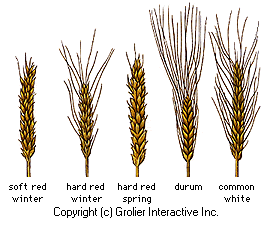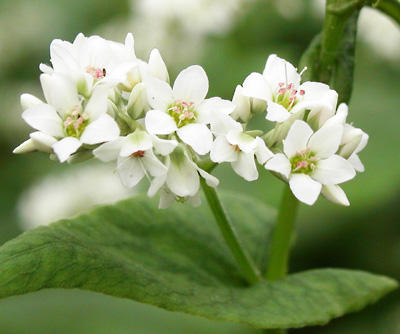
American do-nothing farming: Wheat and buckwheat
My long-term goal is to
grow most of the grains Mark and I eat using Fukuoka's do-nothing
farming
--- utilizing heavy straw mulches from previous crops and a groundcover
of clover to fertilize the soil and prevent weeds from growing in the
field. Unfortunately, I can't seem to find any definitive
information from people who have translated this Japanese method to the
United States, so I'm prepared for the first few years to be dismal
failures. Here's a rundown on the current incarnation of this
experiment.
Wheat
is our winter grain
 The first step in a do-nothing rotation is
finding a winter
grain. From everything I've read, if you live in a climate colder
than zone 7, your choices are slim --- wheat or rye. (Barley is
another option if you live further south.) I'm not a fan or rye,
so wheat will be our winter grain.
The first step in a do-nothing rotation is
finding a winter
grain. From everything I've read, if you live in a climate colder
than zone 7, your choices are slim --- wheat or rye. (Barley is
another option if you live further south.) I'm not a fan or rye,
so wheat will be our winter grain.
Winter wheat should be
planted early enough in the fall that the plants
grow 5 to 6 inches before going dormant (which equates to 8 to 12 weeks
of growth), but late enough that the Hessian fly has died back for the
year. From browsing extension service sites, it sounds like we
should plant our wheat in early to mid October, after the first freeze.
There are half a dozen
different types of wheat, so I expect I'll be
talking about seed choice in more depth in a later post. Here are
the main decisions you have to make when choosing a type of wheat for
your garden:
- Soft wheat, hard wheat, or durum wheat. Soft wheat has less gluten and protein, and is great for baking biscuits and cakes. Hard wheat is high in protein and gluten, so it makes great bread flour or all-purpose flour. Durum wheat is also high in protein, but is low in gluten, so it is primarily used to make pasta.
- Winter wheat or summer wheat.
This is pretty self
explanatory --- one grows in the winter and one in the summer.
This distinction does not necessarily relate to the other distinctions
--- winter wheat, for example, can be soft or hard and red or
white. Clearly, we'll be choosing a winter variety.
- Red
or white wheat.
Among the hard winter wheats, you
can choose between the widespread red wheat or the newly trendy white
wheat. I'm actually intrigued by the latter since it has just as
much nutritional value as red wheat, but results in bread that is
paler, less bitter, and softer --- sounds like just the way to complete
Mark's conversion to whole grains.
Buckwheat
is our summer grain
 The summer grain in a do-nothing rotation
should be of a different
genus than the winter grain so that diseases and pests from the winter
crop won't ruin the summer crop. In addition, the summer grain
needs to mature relatively quickly since the winter grain usually eats
up over half of the year.
The summer grain in a do-nothing rotation
should be of a different
genus than the winter grain so that diseases and pests from the winter
crop won't ruin the summer crop. In addition, the summer grain
needs to mature relatively quickly since the winter grain usually eats
up over half of the year.
My top choice for a
summer grain is buckwheat. This "grain" is
not even in the grass family, so it shares no diseases with wheat, and
it can be planted as late as mid June and still produce a good
crop. I have to admit that I've never actually eaten buckwheat,
but the grain is supposed to have a complete set of amino acids (unlike
other grains, but like meats) and blooms for at least a month, making
it a great nectary for honeybees. Buckwheat flour is often used
in pancakes, but the seeds can also be sprouted or cooked whole (or fed
to the chickens if we hate it.)
On the negative side, buckwheat is not a good choice for bread and the
hulls must be removed before cooking.
Buckwheat likes warm
soil for growing, but cool nights during bloom and
seed set, so it is best planted two to three months before the average
fall frost free date --- July or August here in southwest
Virginia. Unlike many of the true grains which can be left in the
field to dry, buckwheat needs to be harvested before the frost so that
the seeds don't fall to the ground.
| This post is part of our Homegrown Whole Grains lunchtime series.
Read all of the entries: |
Want more in-depth information? Browse through our books.
Or explore more posts by date or by subject.
About us: Anna Hess and Mark Hamilton spent over a decade living self-sufficiently in the mountains of Virginia before moving north to start over from scratch in the foothills of Ohio. They've experimented with permaculture, no-till gardening, trailersteading, home-based microbusinesses and much more, writing about their adventures in both blogs and books.
Want to be notified when new comments are posted on this page? Click on the RSS button after you add a comment to subscribe to the comment feed, or simply check the box beside "email replies to me" while writing your comment.

Can you give us an update on your wheat/buckwheat rotation? Have you learned of similar efforts in the United States since you began your attempt?
I just read The One-Straw Revolution and The Natural Way of Farming by Masanobu Fukuoka, and am very interested in an adaptation of do-nothing farming that can be applied in the United States.
You can read the highlights and lowlights of our backyard grain experiments by clicking on the link above. From my experience (and what I've since learned from others), you have to start with tilled ground to make Fukuoka's method work, and I just ran the chickens over an area before planting at first, which didn't work well.
For my second experiment, I got the chickens to really clear the ground and then went in and dug up any serious roots. During that experiment, I learned that buckwheat is a lot more sensitive to environmental conditions than I had thought, and I again didn't get much harvest. I didn't have weed problems, though, and had no trouble planting winter wheat amid the buckwheat after letting the chickens run through and harvest the buckwheat grain.